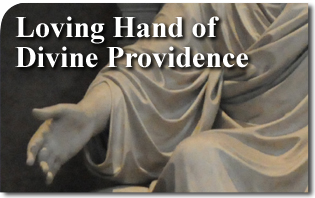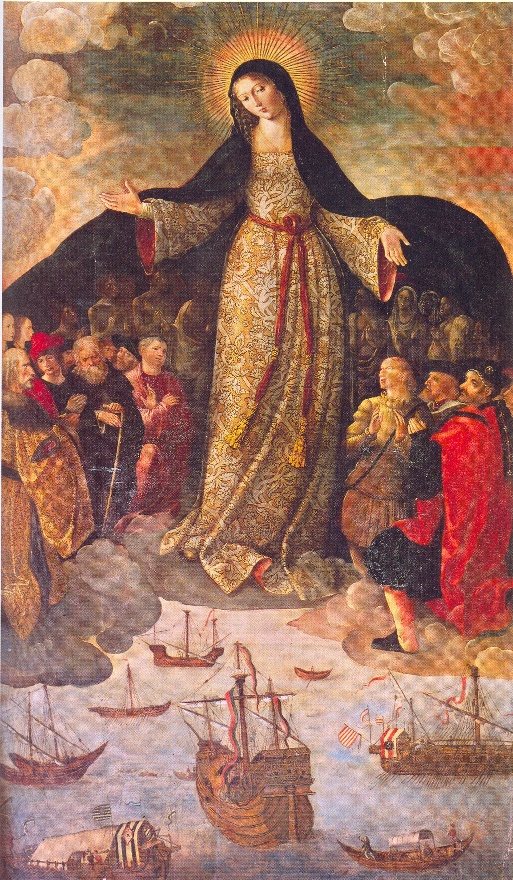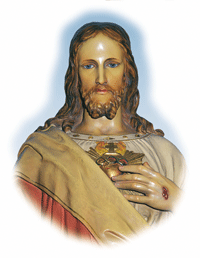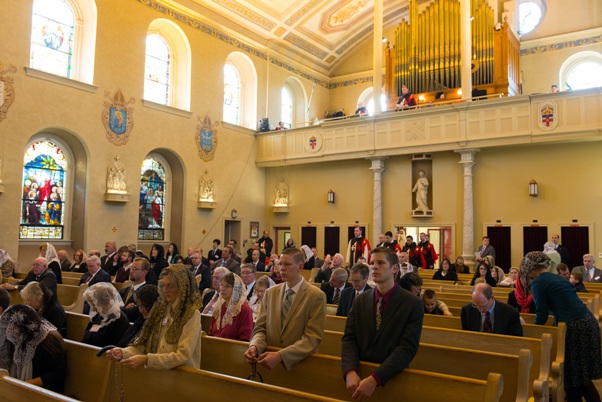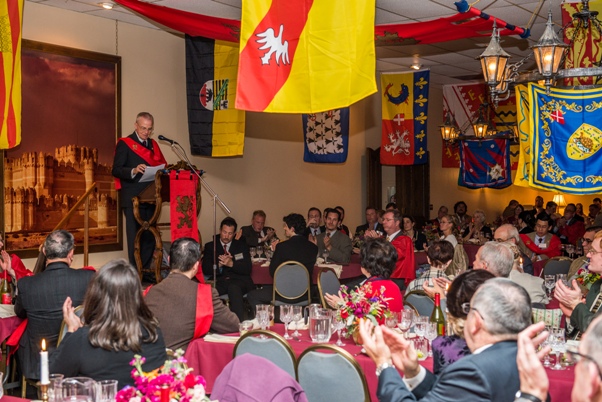by Rex Teodosio
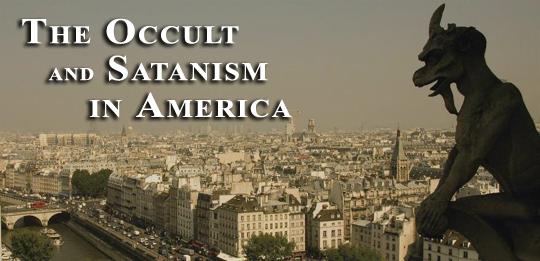
This article-report is based on studies by the author as well as an interview with ex-Satanist Zachary King. It is meant to raise awareness regarding the growing popularity of the occult and Satanism in America, its threat to our children and how society is being transformed to be more accepting of the devil.
Few Americans took notice that in the last U.S. census of 2010, witchcraft had become the fourth largest religion in the United States. As shocking as that may be, Satanism has become just as popular. So says Zachary King, one of the most renowned former Satanists who converted to the Catholic Church, in an interview he gave to Crusade Magazine.
Does the Devil Exist?
When we speak of the occult and Satanism, many readers may have the impression that we are talking about the fabled bogeyman. The bogeyman is in everyone’s nightmares, but it doesn’t really exist. According to a Gallup poll in 2003, only 70% of Catholics believe in the existence of the devil, which is only 2% higher than the average American.[1]
Most Catholics do believe that the devil exists, but is largely absent from their lives. Or perhaps, for our peace of mind, we would like to think he is only distantly involved. Some would rather not talk about it. After all, one of the maxims of the American way of life is “Live and let live.” Let the devil be and hopefully, with a wing but no prayer, he will leave us be.
In a four-hour interview with former Satanist Zachary King, a lot was revealed about the activities and growing popularity of Satanism in America. The interview also showed that children are at a high risk of getting involved in the occult and how much the world is becoming more accepting of the devil. Far from sleeping, the devil has been awake and quite active.

Zachary King, a former Satanist high wizard, converted to Catholicism in 2008.
A Former Satanist Converts
Zachary King converted to the Catholic Church in 2008. His conversion story, which involves the miraculous medal, is a fantastic story in itself, but it is not the focus of this article. He was a former Satanist who reached the degree of high wizard in the World Church of Satan. A high wizard is hand selected by the top leaders. If a satanic high priest is more or less equivalent to a Catholic priest, a high wizard is more or less equivalent to a mystic saint. In this position, he traveled extensively to perform satanic rituals for politicians, CEOs, TV producers and artists. His more than twenty-six years of deep involvement in Satanism has given him insight into this secretive world.
A Blurry Line
The occult and Satanism are nothing new. Many times the distinction between the two is blurred even by authorities who have studied both, since, by their very nature, both deal with the devil, though occultists may not always perceive it as such. This is evident in the book written by Mr. Luis Solimeo and Mr. Gustavo Solimeo, Angels and Demons. Mr. King himself first dabbled in the occult before being recruited into Satanism.
Defining the Occult
The occult is as old as the first temptation in the Garden of Eden when the serpent tempted Eve to become like God by merely eating a fruit. Mr. James R. Lewis, the second most prolific writer on the occult, has a long list of occult movements which includes Wicca, Druids, Voodoo, Brujeria/Santeria, the garden variety of New Age religions, astrologers, psychic readers, spirit mediums, among other less known sects. The terms “witchcraft” and the “occult” are synonymous. Occultism can be defined as the movement of people who believe in harnessing the power of spirits or nature through the use of herbs, crystals, amulets, incantations, symbols and spells for either “good” or “bad” effect.
The practice of the occult has always been popular and public throughout history. We see the practice in different forms like the priests of the Pharaoh whom Moses fought, Simon the Magus whom Saint Peter confronted, or the druids Saint Patrick challenged. Occultism was universally prevalent in pre-Christian times.

Ever since Saint Michael the Archangel expelled the fallen angels from heaven, they seek to destroy God’s creation by turning man away from God to the point of worshiping Satan himself, the ultimate enemy of God.
“Michael Casts out all of the Fallen Angels” by Gustave Doré.)
Defining Satanism
Satanism can be considered as ancient as the revolt of Lucifer and his angels against God. The former light bearer, as the name Lucifer signifies, deceived a third of the heavenly host and led a revolt against God. There are many variations of Satanism according to Alfred E. Waite, the most published authority on the occult and Satanism. In his book, Devil Worship in France, he defines Satanism as the movement of people who imitate the fallen angels and declare allegiance to Lucifer as a form of defiance to God.
Whereas the occult is an indirect, albeit sometimes unsuspecting, worship of the devil, Satanism is its unabashed counterpart. As Mr. King noted, “the occult dabbles with the power of the devil many times not knowing it.” “Satanists, on the other hand,” he continues, “embrace it fully and openly.”
The presence of Satanism has not been as obvious as that of the occult throughout history. “All the gods of the gentiles are devils (Ps. 96:5),” say the Scriptures. However, Satanism, per se, is the open worship of the devil, and, as such, if it did exist as a movement, was completely secretive in the past.
The Shift in the Soul of Western and Christian Man
The practice of the occult began to diminish markedly as Christianity spread, especially in the lands where it took root. Superstitions were replaced by the true Faith. Pagan rituals were replaced by prayers and the sacraments. The paranormal activities worked by invoking spirits were replaced by miracles wrought by novenas, prayers and devotion to Mary, the angels and the saints. Miracles abounded during the Middle Ages, a period when saints, imbibed by a true Christian spirit, walked the land.
Something changed in the lands where Christianity once flourished. Today, the influence of the Christian faith is much diminished in society. The appeal of witchcraft and, consequently, devil worship returned.
Bishop Fulton Sheen made the saying popular that the greatest trick the devil played on mankind was to make us believe he doesn’t exist. The trick seems to have changed. The devil is now playing a new and improved trick on mankind.
The Resurgence of the Occult and Satanism
According to the above-mentioned 2010 census, there are more people involved in the occult in America than there are Muslims or Jehovah’s Witness. Compare this to polls in 1980 when the people who affiliated themselves with the occult were so statistically small, no specific data was assigned to them. They were grouped with Muslims, Buddhists, Unitarians, and others, which altogether was only 2% of Americans.[2]
The tally of the number of Satanists is harder to come by. According to Zachary King, his conservative estimate is about 4 million in the United States and about 10 million worldwide.
One reason why it’s impossible to have hard figures on the number of Satanists in America is because of the secrecy. The Church of Satan, founded by Anton La Vey, was the first of its kind to officially establish itself as a non-profit religious organization with the U.S. government on September 20, 1971 in California.
The Church of Satan ironically professes to be atheistic. In their belief system, the only god is oneself. The only sacraments are to pleasure oneself in any way imaginable. The only commandment is to do whatever makes you happy. Curiously, however, in their private rituals, they constantly invoke Satan’s name.[3]
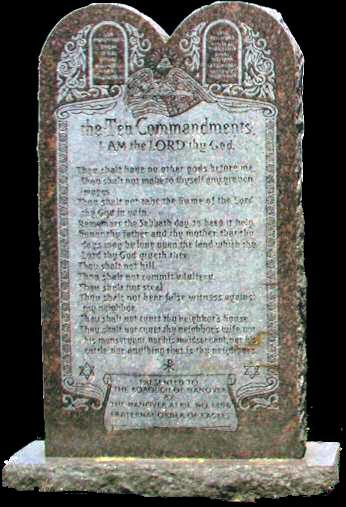
A symptom of the dechristianization of society can be seen in the multiple controversies and lawsuits against the erection of monuments to the Ten Commandments which occur in cities all across America.
The Black “Mass”
Perhaps another mark of their increased popularity is the controversy they have generated in the news lately. The Satanists especially have been demanding public acceptance by trying to distribute books about the devil to school kids, putting up a public monument of Satan in Oklahoma Cityor setting up a “holiday” satanic display next to a nativity scene in the Florida state capitol.
The greatest controversy in 2014 was regarding the satanic black “mass.” On May 12, 2014, Harvard University scheduled a “reenactment” of a black mass. It was canceled by the school due to overwhelming protests. It would have been the first black mass offered to the public in the world.
In September of 2014, a satanic black mass was performed in OklahomaCity’s Civic Center where the admission was opened to the general public. In that sense, it was the first public satanic black mass celebrated in history. It was a public act in a public venue offered to the general public. It was the first time in history that Satan could be worshipped in broad daylight before the whole world. Previously, all satanic activities were done as privately as possible, in basements or in rooms with covered windows, and in the middle of the night.
Shockingly, Zachary King notes that a black mass is much more common than people think. Many high priests will perform it every night starting at midnight, the witching hour, and conclude at 3:00 a.m., the inverse time of Our Lord Jesus Christ’s death on the cross.
What is a satanic black mass? Mr. Alfred E. Waite, author of Devil Worship in France (1886), described it as a ritual based on the Catholic Mass. It is not based on Jewish or Muslim services, nor Buddhist or Hindu rituals, not even Protestant services.
The following is a list of rituals done in a satanic black mass compiled from the writings of Mr. Waite and confirmed by Mr. King.
Just as the Holy Mass is celebrated on top of an altar containing a relic of a martyr, Satanists perform theirs on top of an undressed woman of ill repute. Just as we humble ourselves repeatedly invoking God’s mercy, they offer their acts of constant revolt in imitation of the devil. Just as Jesus is offered as a sacrifice, they offer human or animal sacrifices. Just as we lift our hearts and minds to God asking His presence, Satanists repeatedly implore and demand the presence of demons. Just as we fill our naves with sacred music and chants, they fill theirs with weird music, a gong sounding every time the name of Satan is invoked. Just as we direct our prayers to God, the Blessed Virgin Mary, the angels and saints, they direct theirs to Satan, the demons in hell and the damned souls in hell, especially those who committed particularly heinous sins on earth, like Cain and Judas. In addition, Mr. King added that he even witnessed some Satanists pray the rosary completely in reverse, starting from the last word, “Amen,” and ending with “Hail.”
Three Reasons the Church’s Enemies Hate the Immaculate Conception
Litmus Test: the Sacrilege with Consecrated Hosts
Here is the worst part and what seems to be the main point of their ritual. Just as we receive Holy Communion, believing the consecrated host to be the Body, Blood, Soul and Divinity of Our Lord Jesus Christ and are encouraged to offer acts of faith, adoration, love, thanksgiving, reparation and petition, the Satanists, too, receive “communion.” Real Satanists insist on using a real consecrated host. They then spit Our Lord on the ground, trample all over Him, all the while screaming blasphemies and profanities at Him.
In his book, Alfred E. Waite writes that in order to form a partnership with the “lost angels” one must please Satan. Since Christ is the enemy of Satan, the sorcerer must outrage Christ, especially in His sacraments. Because of this they insist on using a consecrated host and they obtain this by stealing It.
A priest in France wrote last year about a former Satanist who claimed he could tell a consecrated host from an unconsecrated one. This convert claimed that if you put a consecrated host on a table along with ten unconsecrated ones, he could pick out the consecrated one without hesitation. When the priest asked how that was possible since there is no physical difference, the former Satanist said he could do this because of the intense hatred he felt towards that one species.[4]

Although not all pro-abortionists are Satanists, the connection between abortion and Satanism is not surprising. During satanic rituals, aborted babies are offered as human sacrifices to the devil.
Satanism and Abortion
Another shocking aspect of a black mass is the use of abortion. A common image used to portray abortion is that of the false god Moloch whose statue’s mouth is shaped like a burning furnace where babies are thrown in as a sacrifice.
Done completely under the protection of the law, satanic high priests today will assist in an abortion and offer the killing of the baby to the devil. Lawyers are consulted to make sure everything is done according to the law. In addition, many high priests dedicate all the abortions in the world to the devil every night during the witching hour.
Explaining the Shift in the Soul of Western and Christian Man
How did this shift happen? How can society today accept or be indifferent to such heinous acts?
In his masterful book, Revolution and Counter-Revolution, Prof. Plinio Corrêa de Oliveira analyzes the modern-day crisis and explains the changes in the soul of Western and Christian man.[5]
Prof. Corrêa de Oliveira explains how society was transformed in five stages. The historical reference point of his analysis is the High Medieval Ages when the Gospel of Christ pervaded all of culture and society. During this time, the practice of the occult existed, but it was extremely unpopular and it was never public.

Plinio Corrêa de Oliveira, author of Revolution and Counter-Revolution, prognosticated that the Fifth Revolution would be the Satanic Revolution. This revolutionary process attempts to reverse the fruit of Our Lord’s death on the Cross, namely Christian civilization.
The first changes started with humanism and Protestantism in the fifteenth and sixteenth centuries. We see during that time the resurgence of the Greek and Roman deities. As Prof. Corrêa de Oliveira says, “The thirst for earthly pleasures became a burning desire. Diversions became more and more frequent and sumptuous, increasingly engrossing men… Hearts began to shy away from the love of sacrifice, from true devotion to the Cross, and from the aspiration to sanctity and eternal life.” He called this the First Revolution.
The Second Revolution is the French Revolution. In this period we see the proclamation of the goddess of reason. Mr. Waite noted the growth of popularity of the occult and devil worship during this period.
The Third Revolution is the Communist Revolution. Though communism never promoted witchcraft and devil worship, it tried to abolish religion and establish materialism. In all the nations where the errors of communism spread, as predicted by Our Lady at Fatima, the role of God diminished and the role of atheistic materialism increased.
The Fourth Revolution, as defined by Prof. Corrêa de Oliveira, is the Cultural Revolution. During this phase we begin to see the rise of New Age religions and the occult.
All the previous four stages progressed towards one finality: the end of Western and Christian civilization.
What shifted in the soul of Western and Christian man is the influence of Jesus Christ and His cross in the hearts of modern men. The whole revolutionary process attempts to reverse the fruit of Our Lord’s death on the cross which inspired and is the foundation for Christian civilization. We now live in a civilization where more and more Christian values are being eroded and persecuted, and anti-Christian values are being promoted.
Before the author of Revolution and Counter-Revolution died in 1995, he prognosticated that the Fifth Revolution would be the Satanic Revolution.
Hope in Face of the Advancing Satanic Revolution
Within the context of the struggle with the devil, sometimes we are tempted to think that God is an “equal opportunity employer.” God set an enmity between the woman and the serpent in the book of Genesis. There is a “competition” between the two factions. Sometimes we have the impression that God abides by the rule of fair play. There are rules in this “competition” and both sides are given equal opportunity to make their play. Or, so, some may think.
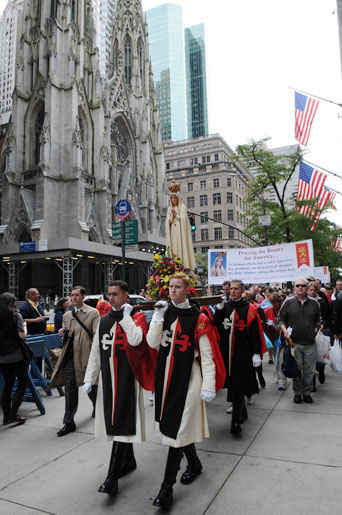
TFP Members in TFP Ceremonial Habits carry a statue of Our Lady of Fatima during the 2009 Public Square Rosary Rally in New York City.
This is not the case. There is no parity between the devil and Our Lady. She was given a super abundance of graces, supernatural gifts and spiritual qualities. She is superior in every spiritual sense to the devil. She has proven this to us again and again.
This is one of the reasons whyThe American Society for the Defense of Tradition, Family and Property always makes the effort to spread devotion to her Immaculate Heart through ourAmerica Needs Fatimacampaign. It is also one of the main reasons why we promote the Public Square Rosary Ralliesevery year. Even as the occult and Satanism grow in popularity and Christianity is increasingly being persecuted, we are confident in the fulfillment of her prophecy at Fatima that her Immaculate Heart will triumph.
Where is the hope in face of the resurgence of the occult and the coming Fifth Revolution, the Satanic Revolution? Even though the media and Hollywood do not give it much notice, the signs of Our Lady’s actions are out there.
A big sign is the 12,269 Public Square Rosary Rallies held in 2014. Crowds from 10 to 500 gathered in public squares all across the country praying the rosary for the conversion of America. This movement has grown from 2,000 rallies to over 12,000 within less than ten years. This is a big sign that Our Lady is active.
Another sign is the increasingly warm reception given to America Needs Fatima Custodians who take replicas of the most famous statue of Our Lady of Fatima to homes around the country. About 2,000 talks were scheduled in 2014. America Needs Fatima members host the statue in their homes, inviting family, friends, neighbors, parishioners and, sometimes, complete strangers for a presentation about the prophecies of Our Lady of Fatima and how to pray a rosary. Here, too, we see the Blessed Virgin Mary very active.
Other signs of hope are the conversions. Zachary King converted in 2008 by an extraordinary grace from Our Lady of the Miraculous Medal. He and his wife now spend their time giving talks about the dangers of the occult and Satanism. His main devotions now are to the Blessed Sacrament and Our Lady.
Another prominent convert is Blessed Bartolo Longo (1841-1926) who became a model of piety. At his conversion from Satanism, he dedicated the rest of his life to expiating for his sins. At one point, he was tormented by doubts that the devil still owned his soul and that nothing he could do would save him from that.
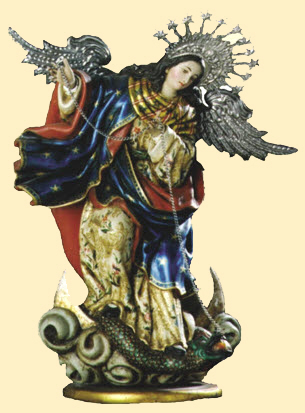
Our Lady of the Apocalypse chains the old serpent who is the devil and Satan. “I will put enmities between thee and the woman, and thy seed and her seed: she shall crush thy head, and thou shalt lie in wait for her heel.” Gen. 3:15
At the height of this temptation, he heard in his ear a promise that said, “One who propagates my rosary shall be saved.”From then on, his mission became clear: to spread devotion to the Holy Rosary. He restored a painting of The Virgin of the Rosary which became the focus of this devotion in the region of Pompeii. The church that houses this painting was raised to a minor basilica.[6]
My Hope With This Article
I pray that this article acts as a warning siren to America. It is not meant to be sensational. It is meant to warn America that the storm is here. The Satanic Revolution, the fifth and final stage of the process of the Revolution, is here and attracting a following. We need to be aware of its dangers. We need to be spiritually prepared for it as best we can.
Devotion to the Immaculate Heart of Mary
I pray that America does not forget the role of the Blessed Virgin Mary in this onslaught. As Mary said at Fatima, to convert the world, “God wants to establish devotion to my Immaculate Heart.”
1.
http://www.gallup.com/poll/7858/Devil-Demographic-Details.aspx. ↑
2.
http://www.gallup.com/poll/1690/religion.aspx. ↑
3.
http://en.wikinews.org/wiki/Satanism:_An_interview_with_Church_of_Satan_High_Priest_Peter_Gilmore. ↑
4.
http://saintfactory.com/satanism-theeucharist. ↑
5.
http://www.tfp.org/books/rcr.pdf. ↑
6.
http://www.santuario.it/fondatore/bioafia.html. ↑
 Imagine the Knights Templar. The Templars asked Saint Bernard to write their Rule and he did. One of the principles he laid down was: never retreat in battle, under pain of mortal sin. Never retreat, in other words, not even a strategic retreat, nothing of the sort. No retreat and that’s the end of it.
Imagine the Knights Templar. The Templars asked Saint Bernard to write their Rule and he did. One of the principles he laid down was: never retreat in battle, under pain of mortal sin. Never retreat, in other words, not even a strategic retreat, nothing of the sort. No retreat and that’s the end of it. 


















